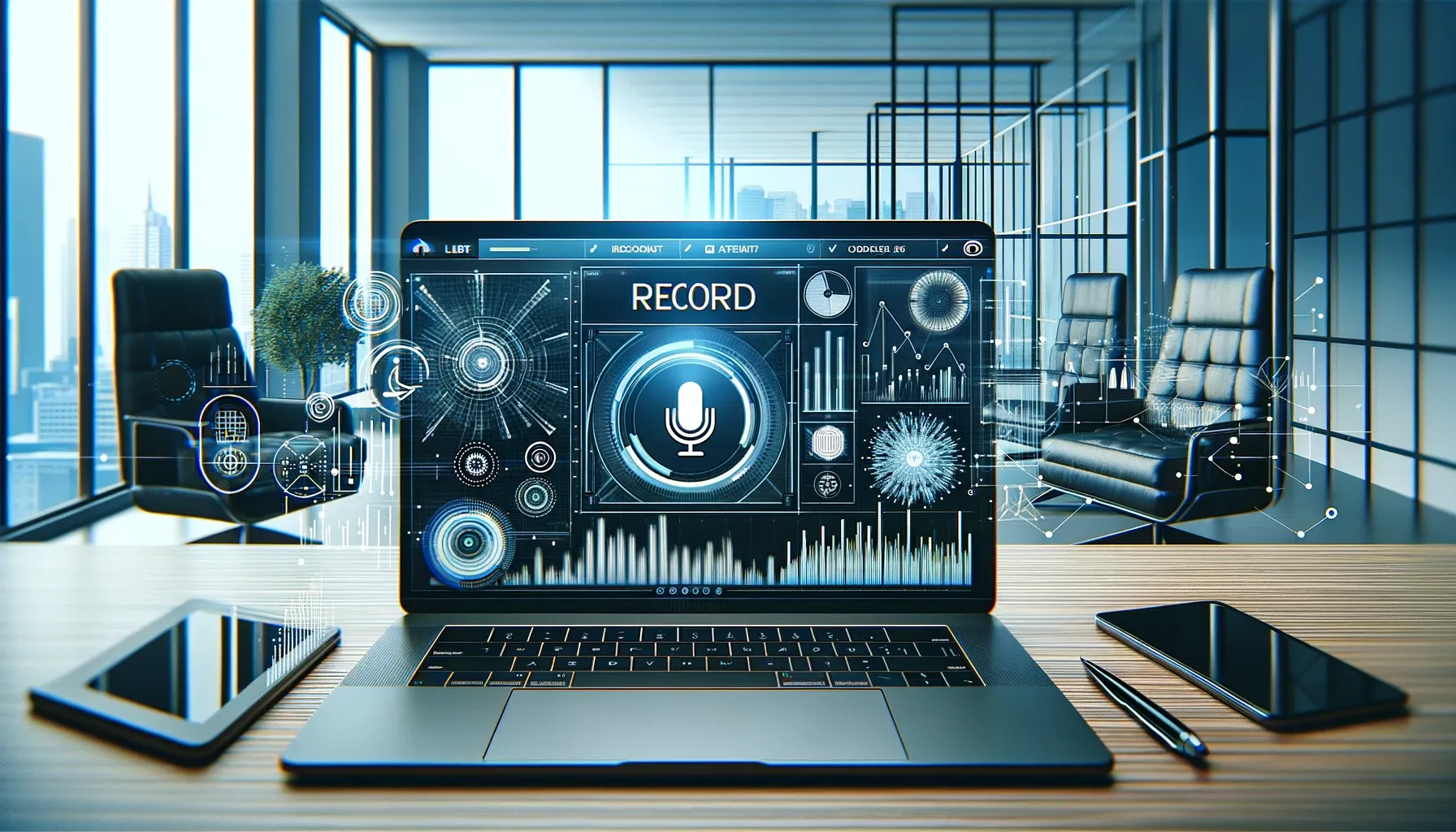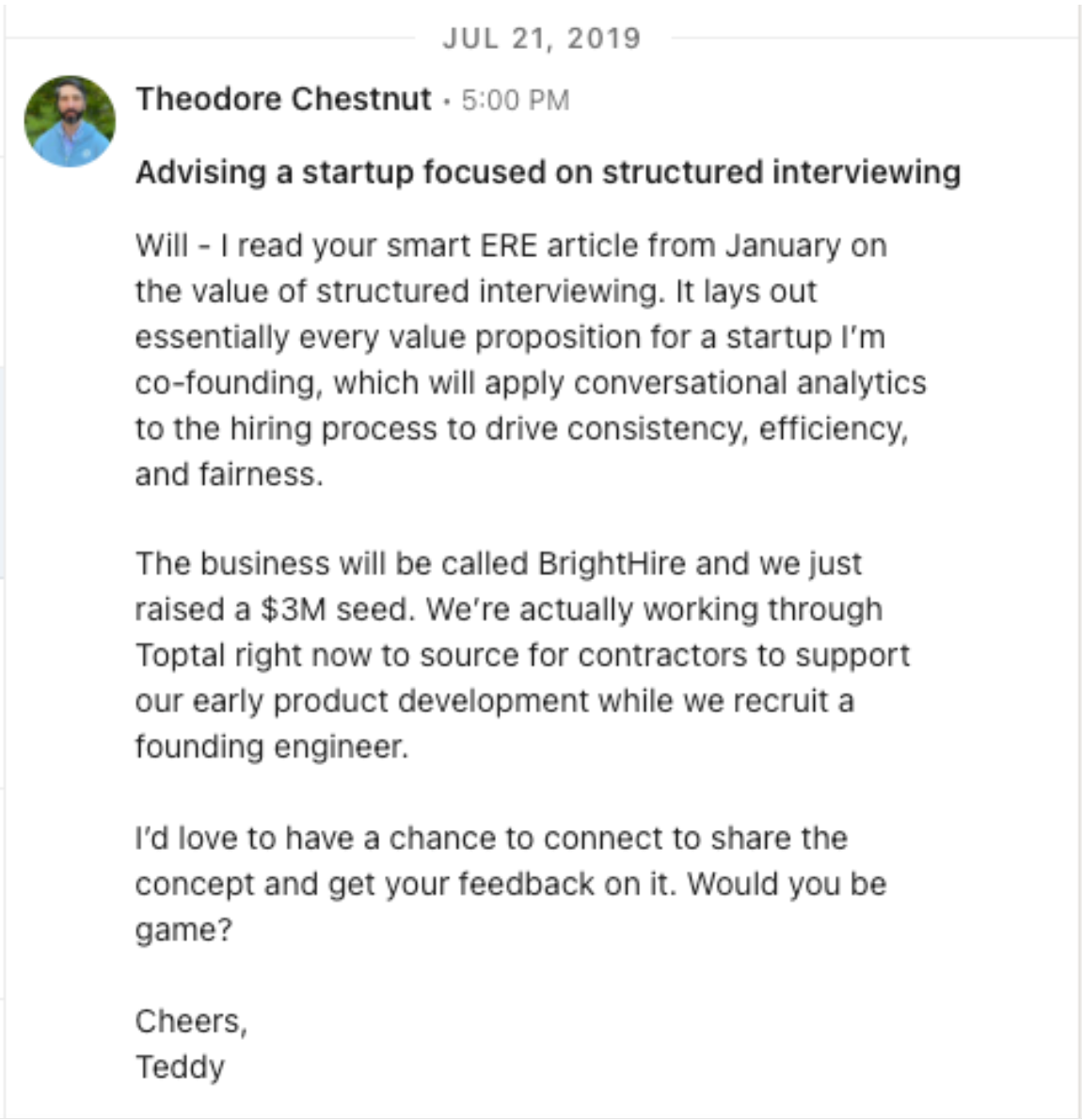A New Era of Interviewing: My Experience with BrightHire
The biggest improvement in live interviewing over the past decade is recording interviews.

[Originally posted on LinkedIn, February 22, 2022]
The biggest improvement in live interviewing over the past decade is recording interviews.
We were already recording some of our interviews. BrightHire allowed us to scale those efforts to make a larger impact.
My BrightHire Introduction

A year later BrightHire was released.
When Teddy shared that I was able to pilot BrightHire for the first time, I immediately suspected that a decade’s worth of habits were about to be changed.
Before BrightHire, my workflow was to open a document with my interview questions ready to go. As I asked questions of the candidate, I would try to capture every word they said by typing their response. I’d use these notes throughout their interview process, and they helped me develop compelling closing conversations.
BrightHire transformed that approach.
BrightHire is an interview intelligence platform that integrates with your ATS and enables every interviewer to feel prepared and confident in assessing candidates. The platform records the interview and features a built-in customizable interview assistant that lists predetermined interview questions to guide each interview. The guide time stamps where a question is asked so they can quickly be found after a call. Behind the scenes analytics are generated, providing insights on where in the process you and your team can improve.
Recording your interviews and having a searchable transcript changed my entire workflow for the better. When the entire interview team leverages the platform, better hiring outcomes are achieved, candidates have a more positive experience, and interviewers get better.
If you create a structured interview process, leverage BrightHire across all of your interviews, and take action on the insights from the analytics, you will make better hiring decisions.
Objections
Following the status quo is the best way to lose in a talent-driven market.
“My hiring teams won’t use it.” “The transcript isn’t perfect.” "I don't want to be recorded." "What about the candidate experience?"
Most people react to learning that they will be recording their conversations with fear. Common responses are, "I don't want people to listen to what I am saying," or "What if I say the wrong thing and end up fired?"
My answer to these concerns is this: My goal is to help teams challenge the status quo. Instead of focusing on fear, think of the positives and build the case for helping your organization achieve better hiring outcomes.
As a talent leader, you should do everything possible to help your recruiting team.
As a recruiter, your organization wants to help you. BrightHire empowers a cycle of feedback and improvements. Reviewing your interviews allows you to self-critique and make instant changes to become better.
Hiring managers want recruiters to succeed and help you portray an accurate representation of the role and team. Welcome their feedback!
Our goal as partners to our hiring teams is to help them hire the best people for their team in the short and long term. As Lou Adler points out, we need to hire for the first year anniversary date.
A key metric to look at for the success of your hiring program is the one-year retention rate. This is the best predictor that your job description, structured hiring process, transparency of work and team environment, and goals for the role are all being accurately presented to the candidate. [Assuming you want long-term workers.]
Becoming better and reducing bias
Defining the interview process is the most challenging part of hiring. The hiring team needs awareness of their current objectives and future needs, and then translate those into the skill sets required to achieve those objectives. Without structuring the interview process up-front, you’ll end up wasting time and creating bad experiences for candidates.
Using BrightHire’s interview assistant reduces the likelihood of bias and ensures all candidates are considered fairly. As a Talent Leader, you no longer have to guess what’s happening in interviews. You can quickly spot trends and provide immediate coaching to your hiring teams on ways to improve.
Reviewing interview recordings also allows you to assess how recruiters are pitching the role and company. You’ll understand if recruiters are treating candidates similarly by starting and ending interviews consistently.
Being able to dive into conversations increases how teams understand the talent market, helps you identify trending topics across different candidates, and makes it simple to create a list of relevant candidate FAQs. For example, it takes just a few keyword searches to discover how often candidates are asking about compensation, benefits, equity, PTO, culture, and mission.
When a business leader asks how many candidates are looking for remote only positions, you no longer have to rely solely on what recruiters captured within your ATS. A quick search in BrightHire surfaces full context on how many times “remote only” (and other related keywords) came up in interviews.
Capturing the interviews provides an opportunity to create a great question and answer bank to compare candidate responses for each specific competency. If we had a misstep in hiring, I could also reflect back on our interviews and identify improvements.
Coaching and 10x shadowing
Have you ever wondered any of the following:
- How do you get your newest recruiters up to speed?
- How do you identify coachable moments?
- How do you enable self-learning and review?
- How can you determine if your recruiters are providing a consistent message?
- What are my hiring teams asking?
When a new recruiter starts, most organizations have the recruiter shadow interviews of the most experienced team members. This has generally resulted in a lot of “fun” three-way calling experiences and uncomfortable candidate experiences.
Recording your interviews allows you to create a repository of interviews that you can share with new recruiters. They can listen as many times as they like without having to join a live call at a specific time. The recruiter can also see which interviews were highly rated, and also listen to candidates that didn't achieve high marks.
New recruiters can track hiring results with the integration of the ATS and gain a strong understanding—from their first interview—which candidates will do well in the interview process. This is a huge advantage for evergreen positions, or for understanding how specific teams or departments are assessing candidates.
BrightHire also helps with dreaded reverse shadowing challenges. How stressful is it for new recruiters leading their first candidate call with another recruiter listening in the whole time? Recorded interviews allow new recruiters to share the call and hear what they can improve in their next call. Recording interviews brings us insights we never had great access to.
The interview assistant and the ability for 10x shadowing experiences helps new recruiters get up to speed much faster and have more confidence when they conduct their first interviews. You'll also be able to identify coaching moments for your interview teams. This alone brings talent business partnerships to the next level.
By watching my hiring manager's interview, I learned why we had such a high rate of success with hiring. This particular hiring manager would ask a question, listen to the response, and then immediately provide feedback on where they did well and what could be improved. This hiring manager started the coaching process on their first interaction. BrightHire allows you to identify your talent magnets like never before.
Putting Candidates at Ease
When I schedule my recruiter screens, I let candidates know that we'll be on Zoom and that the call will be recorded. This gives them plenty of time to opt-out or mentally prepare to be recorded. Most of my calls start with a quick overview of what BrightHire is, why I am excited about it, and why it is better for them.
My hiring team has full access to this interview and you can have confidence knowing that I won't be deciding the outcome of your candidacy in isolation.
I also end all of my interviews with this single question, "Is there anything we missed that you want me or the hiring team to know?" This gives them an opportunity to share whatever they want and also gives them some control over how the interview ends. This increases their perceived fairness of the interview and ultimately their candidate experience.
BrightHire gives you the ability to pause or cancel the recording at any time. If there are sensitive topics you don’t want the hiring team to have access to, you can save those questions for the end. You’ll pause the interview and will still have access to the entire interview up to that time.
Bringing it all together
Including BrightHire in every interview in your organization empowers your people to autonomously learn and grow. They can proactively learn from their interviews and identify where they can get better.
Recruiters are also able to watch the hiring team interviews and learn more about the role and identify coachable moments for the interviewer. Interview intelligence gives every team visibility into the questions that were and weren’t asked, and which questions lead to insightful conversations.
You'll be able to review hiring outcomes as new hires turn into tenured workers by reviewing their interviews and identifying useful information to iterate on your interview process.
Challenging the status quo and improving the current standard takes courage and a willingness to fail. Leaders must look past excuses and blockers and focus on the possibilities. Your candidates and business leaders will thank you.
As we were rolling out BrightHire to one of our teams, a recruiter told me, "BrightHire is the best thing ever and I can’t imagine going back." She wasn’t even using the interview assistant, and you can imagine how the excitement built from there.
You may still have questions. That’s normal. I invite you to investigate this technology and give it a try. You can always go back to how you’ve always done it. Trust me, you won’t want to.
